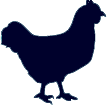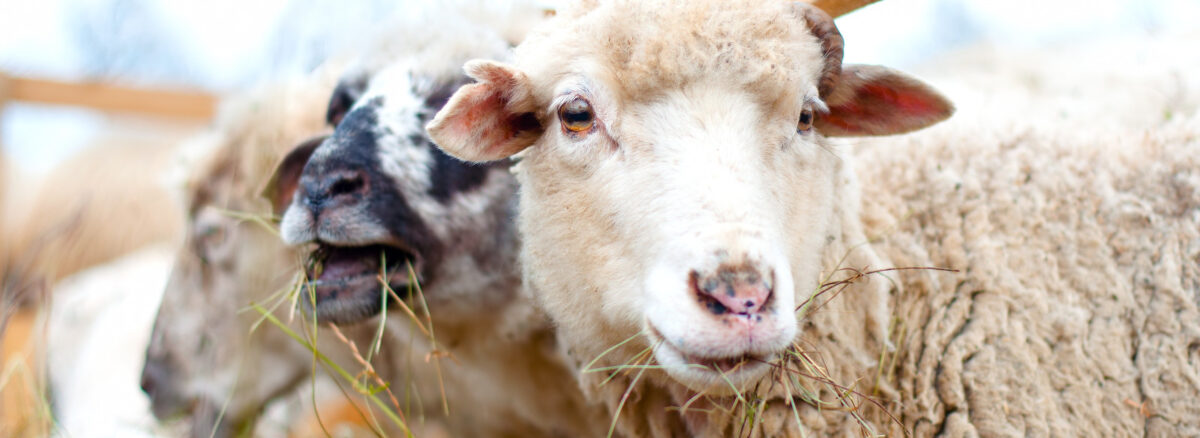Handling Sheep
When working with sheep, be very calm and gentle in your approach. Sheep are suspicious animals by nature and will spook easily if you yell or handle them roughly. When handling your sheep, use a rope halter (available at farm supply stores or through catalogs). If your sheep have horns, you can hold them help control the sheep, although many sheep do not like to have their horns used in this manner .If possible, it is best to have someone assist you. Once caught, some sheep will lie down automatically, and you can have your assistant cradle the head and pet them while you are working on them. Handling your sheep too roughly will cause them to struggle more, so the best approach is to apply just enough restraint to keep them still while you work with them.
Tethering.
Tethering your sheep (putting them on a long leash) is never recommended because it can be stress full to them.
Tethering can also be extremely dangerous; sheep can hang themselves on a tether.
Identification
If you have a large flock of sheep, it is important to be able to identify each sheep individually. Farm Sanctuary uses leg bands. When using leg bands, however, make sure they are not too snug when the sheep is shorn or unshorn. Check leg bands monthly if a sheep is still growing. A leg band that is too tight can cause discomfort and even serious injury.
Shelter Requirements for Sheep
Building
For sheep, we recommend the use of a pole barn or a building with a dirt floor rather thana shed or a house with a wooden floor .If sheep slip ,they may tear ligaments or damage joints , so the best precaution n is to use a shelter with a dirt floor .Allow at least 25 square feet per sheep and be sure the shelter has good ventilation and no direct drafts. Always provide your sheep with plenty of clean, dry straw for bedding. Remove damp and soiled straw daily, replacing it with fresh straw. Hydrated lime will help absorb moisture and prevent spread of bacteria. Spread it lightly on any wet areas.
Fencing
In addition to adequate shelter, you will need a fenced-in area for your sheep. The ideal fencing to use for sheep is 4-foot high, no-climb, woven-wire horse fencing, available at farm supply stores .Field fence has large square openings, and sheep, especially those with horns, can easily get their heads caught. Be sure to walk your fence line frequently to check for holes dug by predators under the fencing. The use of high tensile electric fencing is also an option, especially if you are housing cattle and sheep together.
Pasture
We recommend allowing one acre of land for every three to six sheep. This acreage may vary, depending on the type of land available. In areas that experience hot weather, pastures should have shaded areas for the sheep to prevent them from overheating. Sheep should always have access to their barn and to fresh water, especially during hot weather.
Health Care for Sheep
Maintenance Care. Sheep are relatively easy to care for. Sanitary housing, good quality pasture, nutritious food, fresh water, minerals, and basic maintenance care are their main requirements.
Hoof Trimming
Sheep need to have their hooves trimmed every six to10weeks.This is a very important task because neglecting hoof trimming can lead to lameness and infection in your sheep .Hoof trimming is a simple procedure that your veterinarian can teach you. Hoof trimmers are available through farm supply stores or catalogs. Make sure your pastures have good drainage because wet, muddy areas lead to more serious hoof issues, including foot and hoof rot.
Shearing
Sheep need to be shorn once a year in the spring .Unless you are a trained shearer ,we always recommend that you hire a professional shearer .Your local County Agricultural Extension agent or veterinarian should have a list of sheep shearers in your area. During your daily contact with your sheep, always be on the lookout for any physical or behavioral changes. Symptoms indicating illness include loss of appetite, weakness or staggering, labored or fast breathing, diarrhea, or lameness .If any of these symptoms occur ,pull the animal from the flock and conduct a full health check .If you cannot determine the cause of the condition, consult your veterinarian.
Vaccines
Make sure your sheep are vaccinated for rabies, tetanus, and Clostridium(Bar-Vac CDT).The rabies vaccine can behard on sheep; therefore other vaccinations being administered should be given at least one month before or one month after the rabies vaccine.
Teeth
Sheep can have dental issues and, often, as they age, their teeth develop sharp points .If your sheep are demonstrating exaggerated jaw movements when eating or going off feed, a quick dental check by your vet may be necessary .Do not put your hand in the mouth of your sheep. They have strong jaws and very sharp back teeth. Unless you have experience examining sheep’s mouths, leave this task to a vet
Common Health Issues of Sheep
Upper Respiratory Infection. A respiratory infection is any condition that affects the sheep’s breathing apparatus, including the nose, trachea/windpipe, bronchi, and lungs. Symptoms include nasal discharge, excessive coughing or sneezing, loss of appetite, and raised body temperatures. If any of these symptoms occur, consult with your veterinarian immediately










